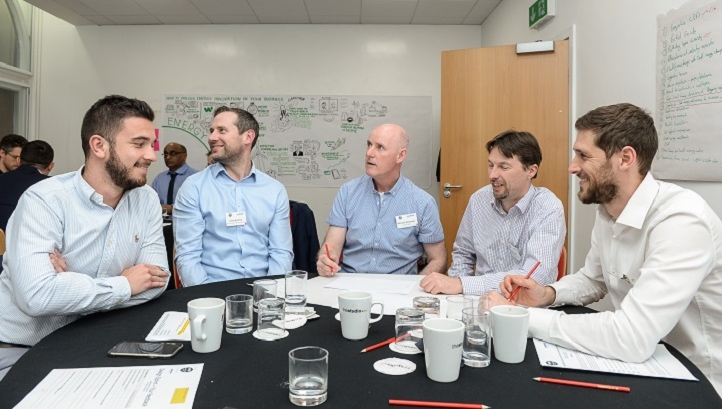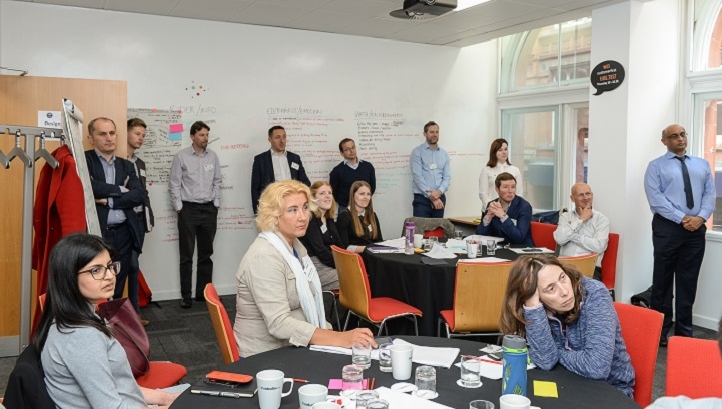Register for free and continue reading
Join our growing army of changemakers and get unlimited access to our premium content

Chris Gaylard of Network Rail presented his team's thinking at the design sprint in Birmingham
The concept of ‘design thinking’ has revolutionised businesses eager to move away from traditional siloes and create new approaches to processes, programmes and brands. It was first developed by the CEO of Proctor and Gamble (P&G), A.G. Lafley, who decided in 2001 that the FMCG firm required new ways of thinking to revolutionise its product range. That project saw a group taken out of their traditional job roles and placed into a design-thinking arena in which, for example, a sales person may assess packaging, or a research and development scientist might help with marketing communications.
Taking this a step further, the ‘design sprint’ concept was developed by Google Ventures as a full, five-day methodology. This “human-centred” approach to design allows groups to define, ideate, prototype and test potential solutions to a challenge, before going through a round of feedback and redesign.
So, could such an approach be applied to energy professionals in a way that could help them unlock innovation and drive behaviour change? That was the question edie sought to answer through a bespoke event held exclusively for members of our Energy Leaders Club, in association with Centrica Business Solutions. Workshop space booked, professional facilitators hired and live illustrators on hand – it didn’t take much convincing to gather 30 energy managers for two, concurrent workshops. The only caveat: we had one day, not five, to work with – so, we consolidated the design sprint approach.
Transferable example: Food waste
Chris Sherwin, director of consultancy Reboot Innovation, led one of the workshops which focused specifically on how energy managers could increase the innovation potential of their team and wider workforce when it comes to managing and reducing energy consumption.
The day began with the group looking at a “transferable design thinking example” put forward by Sherwin from another industry – Rupert Hill, marketing manager at Winnow Solutions, Skyped the group to talk through how his organisation has been tackling food waste within the hospitality sector. Hill outlined the creation of a food bin monitor system, recently trialled by Ikea, which showed how setting up an idea ultimately led to long term reductions in food waste. The business has already seen $30,000 of savings for customers and 50,000 meals redistributed as a result of its product coming to market.
On the Skype call, Rupert responded to a question in the room from David Cast, group climate change director at NSG Pilkington, who asked about getting staff buy-in to the product. Rupert said chefs had become “proud of efficiency”, and although there was an initial challenge of staff seeing the requirement to enter food products into a system before disposal as ‘just another job’, Winnow’s AI technology was able to remove this human concern.
Whilst not directly connected to energy management, Winnow’s example had plenty of takeaways for energy managers. Take data, for exmaple: the rich dataset created from Winnow’s bin system showed chefs where there was wastage and the opportunity for greater efficiency in the kitchen and financial savings. Also, through gamification of the product – kitchens can compete with each other for coming top of the ‘food waste table’ – the competitive streak within chefs was played upon and they began to take a greater pride in their own kitchen’s performance.
Sherwin said that the Winnow example showed how any aspect of innovation – whether it be in energy or otherwise – has to come down to “solving a doable problem” and only by focusing on one specific area would genuine change be enacted.
“We are talking about big problems, like decarbonisation, but we will have to drill down into specifics,” Sherwin said.
John Lewis & Partners’ operations manager for energy and innovation, Neil Coleman, agreed, adding that it was important to create examples through the design thinking process that were scalable and where simplicity was important. “It’s cost that is the driver, not waste,” Coleman said of the Winnow example. The rest of the group agreed that it was important to build a viable business case for the development of any ‘energy innovation’ before making it a reality.
The fifth ‘d’
To this point, Sherwin spoke about ‘Goldilocks syndrome’: an energy management challenge can be too hot (or too big) or too cold (not big enough) – so, part of the energy manager’s role is in identifyign the energy management challenges that are “just right” for innovation to be applied.
“You can’t redesign capitalism, but it can’t be too small, such as removing a screw or a bolt from a system,” Sherwin said. “It’s about you – clients often give you the wrong problem, so identifying the right problem is critical”.
The group went onto talk about the challenges surrounding the so-called Four D’s of business energy – decarbonisation, decentralisation, democratisation and digitisation. A fifth D was even thrown into the mix: dissemination of ideas. This new D, the group agreed, is critical to unlocking energy innovation in business.
We then split into sub-groups to begin focusing on real-life energy management challenges. Group 1 decided to look at the messaging of an energy management strategy – specifically, how it might be possible to unlock energy innovation across a business through effective communication and sharing the message of sustainability. The group discussed accessing and learning from the large collection of ‘green’ or sustainability-related days in the annual calendar, such as Earth Day, Fair Trade Day and Climate Action Week. They agreed it was important to create a shared culture internally across the workforce, where the means – and not necessarily the ends – were discussed, as part of the story around a company’s activities.
Over on the other side of the room, Group 2 looked at “piggybacking on the current national awareness of climate change” – as illustrated by the Extinction Rebellion and youth climate protests; Greta Thunberg, the Committee on Climate Change report, and the UK Government’s decision to call a climate emergency – to drive energy up the corporate agenda.
The two groups created user personas specific to their tasks. For Group 1, the persona of a CEO was created: an individual who may be reluctant to embrace change or view sustainability as an obligation rather than a value – but who also saw the bigger commercial picture and came to the role with significant experience. CEOs are “visionaries” who are influenced by competitors and see leadership on issues such as CSR and sustainability as a “badge of honour”, the group concluded. The challenge, then, is to encourage CEOs and their boards to “recognise the value of energy and not view it as an obligation”.
For Group 2, analysing how to “piggyback” on the current public focus on climate change, the persona created was that of the “average UK employee” – someone who may look at things in a relatively practical way. They split this persona into two categories – a younger person who wants to be more innovative and progressive; and an older person who simply wants to get the job done. The group agreed that it was important to turn the younger demographic into “champions” who “see climate change as the next plastics issue” – and the opportunity, then, is in “targetting the local influencer” who could shift hearts and minds in the workforce.
10 ideas, 10 minutes
Sherwin then tasked both groups with a quick-fire creative round to identify how to target these personas with specific energy innovations – the more radical, the better. Both teams developed a series of possible concepts. These included a business hosting presentations from a local school (playing into the ‘Greta Thunberg effect’); naming and shaming worst energy offenders within businesses; and creating gamification-based energy-savings schemes which could see employees earn credit for implementing green measures.
These ideas then bagan to evolve: the group looked at how employees could best be targeted around energy, from visualisations in communal areas through to ‘digital ideas platforms’ where an average employee could suggest an energy-related change to board-level. The ideas that were eventually decided upon to develop further were a renewable energy supply club; and the subsidising of ‘green’ buying at home, such as kettles, light bulbs, triple-glazing and technological solutions such as Nest or Hive heating products. The group settled on consumer product subsidies as the best method to piggyback on the current climate change public awareness.
Other notable ideas included bespoke CPD opportunities, Earth Day-style events, monthly meetings with ‘energy champions’, sustainability information being included on payslips, incentivising the purchase of electric vehicles, apps which gamify energy performance in the office space, media and marketing opportunities such as newsletters, and more direct learning opportunities from peers. Of these, the group agreed that incentivising and linking of energy performance to bonuses could be a highly effective way of influencing employee behaviours and creating much-needed cultural shifts around energy within the workplace.
Utilising the skills of our live illustrator who was visualising the workshop, two mocked-up ‘products’ were delivered from these top-line concepts which had been agreed upon at the end of the day. The group went as far as creating a retail app on a cardboard iPad; and using a Lego model and visual techniques to illustrate the staff incentives scheme.
Of course, these specific solutions are not going to be scaled-up or commercialised, but the workshop particpants agreed that the methodology taken to generate such advanced ideas in just a few hours was hugely inspirational. Several left thinking about how they could apply the lessons from this design sprint into their own training and sustainability communications strategies.
Commenting on this Design Sprint, Centrica Business Solutions’ sales director Ian Hopkins said: “When different people from different sectors share their ideas, the creativity flows and the magic really happens.
It was fascinating to gain new perspectives and explore innovative new ways to improve the messaging around advanced energy management strategies. I took home some valuable thoughts on how our business can encourage boards to recognise the potential of energy as an asset, rather than an overhead, and to persuade them to embrace new technologies, such as artificial intelligence and Virtual Power Plants, to transform energy performance.”
James Evison




Please login or Register to leave a comment.